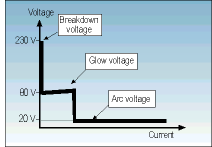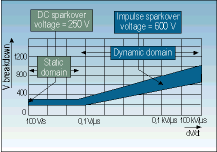
Gas discharge tube components are made of two or three electrodes in an enclosure filled with a (non-radioactive) rare gas at a controlled pressure. The enclosure is a ceramic tube with its ends closed off by metal caps that also serve as electrodes. Their main use is to protect telecommunications lines.
Operation
The gas discharge tube may be regarded as a very fast switch, having conductance properties that change very rapidly, when breakdown occurs, from open-circuit to quasi-short circuit (arc voltage about 20 V). There are accordingly four operating domains in the behaviour of a gas discharge tube:
* Non-operating domain: characterised by practically infinite insulation resistance.
* Glow domain: at breakdown, the conductance increases suddenly; if the current drained off by the gas tube is less than about 0,5 A (this is a rough value that differs according to the type of component), the glow voltage across the terminals will be in the 80-100 V range.
* Arc regime: as the current increases, the gas discharge tube shifts from the glow voltage to the arc voltage (20 V). It is in this domain that the gas discharge tube is most effective, because the current discharged can reach several thousand amperes without the arc voltage across its terminals increasing.
* Extinction: at a bias voltage roughly equal to the glow voltage, the gas tube recovers its initial insulating properties.

Electrical characteristics
DC sparkover voltage
This is the main characteristic defining the gas discharge tube. It is the voltage at which breakdown will occur between the electrodes when a slowly increasing voltage (dV/dt = 100 V/s) is applied to the component; it depends on the electrode spacing, the pressure, and the properties of the gas mixture and of the emissive substance.
The range of DC sparkover voltages available are: minimum 25 V; average 230 V; high voltage 500 V; and very high voltage 1000 to 3000 V. (The tolerance on the breakdown voltage is generally ±20%.)
Discharge current
This depends on the properties of the gas, the volume, and the material and treatment of the electrodes. It is the major characteristic of the gas discharge tube and the one that distinguishes it from other protection devices (Varistor, Zener diode, etc.): 5 to 20 kA with an 8/20 µs impulse for the standard components. This is the value the device can withstand repeatedly (say for 10 impulses) without destruction or alteration of its basic specifications.
Impulse sparkover voltage
Sparkover voltage is the presence of a steep rise front (dV/dt = 1 kV/µs); the impulse sparkover voltage increases with increasing dV/dt.

Insulation resistance and capacitance
These characteristics make the gas discharge tube practically 'invisible' in a line in a steady-state context: insulation resistance very high (1 GΩ), capacitance very low (<10 pF).
3-electrode configurations
Protecting a two-wire line (for example a telephone pair) with two 2-electrode gas discharge tubes (connected between the wires and ground) may cause the following problem: the line is subjected to an overvoltage in common mode; because of the dispersion of the sparkover voltages (±20%), one of the gas discharge tubes sparks over a very short time before the other (a few microseconds); the wire that has sparked over is therefore grounded (neglecting the arc voltages), turning the common-mode overvoltage into a differential-mode overvoltage - very dangerous for the terminal equipment. This risk disappears when the second gas discharge tube arcs over (a few microseconds later).
3-electrode geometry eliminates this drawback; the sparkover of one pole causes a 'general' breakdown of the device almost instantaneously (a few nanoseconds) because there is only one gas-filled enclosure.

End of life
Gas discharge tubes are designed to withstand several impulses without destruction or loss of the initial characteristics (typical impulse tests: 10 times 5 kA impulses of each polarity). On the other hand, a sustained strong current (eg, 10 A r.m.s. for 15 s, simulating the fall of a power line onto a telecommunications line) will put the device out of service indefinitely.
If a failsafe end of life is desired (ie, a short-circuit that will report the fault to the user when the line fault is detected), gas discharge tubes with the failsafe feature (external short-circuit) should be chosen.
The Citel line
Citel offers a line of gas discharge tubes, certified radioactive-free, to meet most configuration needs and specifications found on the market:
*p 2 and 3-electrode gas discharge tubes.
* Sparkover voltages from 75 to 3000 V.
* Discharge capacities from 2,5 to 150 kA.
* Optional external short-circuit device.
* Installation on support, on printed circuit, or surface-mounted devices.
They comply with the specifications of most telecom operators and with the ITU-K12 international recommendation.

© Technews Publishing (Pty) Ltd | All Rights Reserved